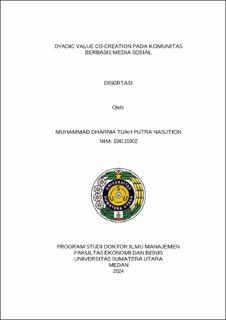| dc.contributor.advisor | Rini, Endang Sulistya | |
| dc.contributor.advisor | Sembiring, Beby Karina Fawzeea | |
| dc.contributor.advisor | Silalahi, Amlys Syahputra | |
| dc.contributor.author | Nasution, Muhammad Dharma Tuah Putra | |
| dc.date.accessioned | 2025-05-09T08:11:24Z | |
| dc.date.available | 2025-05-09T08:11:24Z | |
| dc.date.issued | 2024 | |
| dc.identifier.uri | https://repositori.usu.ac.id/handle/123456789/103753 | |
| dc.description.abstract | The current study aims to develop and empirically test a proposed theoretical model that advances understanding of collaborative value creation within social media-based communities. Specifically, the research focuses on customer-to-customer (C2C) interactions and the allocation of operant resources during these exchanges. It addresses a critical gap in the literature by examining the roles of individual customers in dyadic interactions and the underlying mechanisms that facilitate collaborative value creation in social media contexts. By integrating the Customer-Dominant Logic framework, the Virtual Customer Environment, and New Social Exchange Theory, the study explores how resource integration and customer interactions contribute to value creation. The research adopts a descriptive-conclusive design with a quantitative approach, aimed at investigating the collaborative value creation process within brand communities on social media, with a particular focus on the Wardah and Travelers communities. Data for this study were collected cross-sectionally through surveys using non-probability sampling techniques. The primary data collection involved measuring key variables such as customer value co-creation, operant resources, customer social participation, resource integration activities, and mutually beneficial interactions. Conducted between June 2023 and January 2024, the study targeted individual users actively engaged in these brand communities on social media. The findings demonstrate that collaborative value creation is driven by customers” active engagement in operant resource allocation, which fosters a positive synergy in their interactions. Further analysis reveals that these interactions are influenced by both individual characteristics and the broader social context, underscoring the importance of understanding contextual factors in the collaboration process. This research highlights the critical role of interactions and resource integration in driving value creation among participants. By applying the concept of value-in-context, the study sheds light on how value is co-created not only through final outcomes but also through the processes and contexts of social interactions. These results provide a significant contribution to enriching the theoretical development of collaborative value creation within customer-driven ecosystems, offering practical implications for marketers seeking to enhance customer collaboration through social media platforms. | en_US |
| dc.language.iso | id | en_US |
| dc.publisher | Universitas Sumatera Utara | en_US |
| dc.subject | Customer Social Participation | en_US |
| dc.subject | Mutually Beneficial Interactions | en_US |
| dc.subject | Customer Operant Resources | en_US |
| dc.subject | Resource Integration | en_US |
| dc.subject | Value co-creation | en_US |
| dc.subject | Social Media | en_US |
| dc.title | Dyadic Value Co-Creation pada Komunitas Berbasis Media Sosial | en_US |
| dc.title.alternative | Dyadic Value Co-Creation in Social Media-Based Communities | en_US |
| dc.type | Thesis | en_US |
| dc.identifier.nim | NIM198115002 | |
| dc.identifier.nidn | NIDN0013056205 | |
| dc.identifier.nidn | NIDN0012107402 | |
| dc.identifier.nidn | NIDN0006046603 | |
| dc.identifier.kodeprodi | KODEPRODI61001#Ilmu Manajemen | |
| dc.description.pages | 484 Pages | en_US |
| dc.description.type | Disertasi Doktor | en_US |
| dc.subject.sdgs | SDGs 8. Decent Work And Economic Growth | en_US |


